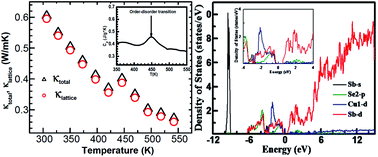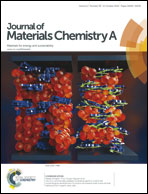Thermoelectric properties of Cu3SbSe3 with intrinsically ultralow lattice thermal conductivity†
Abstract
We report the synthesis, characterization and evaluation of the thermoelectric properties of Cu3SbSe3 with a view to explore its utility as an useful thermoelectric material due to its intrinsically low thermal conductivity. Cu3SbSe3 was synthesized employing a solid state reaction process followed by spark plasma sintering, and the synthesized material was extensively characterized for its phase, composition and structure, which suggested formation of a single-phase. The measured electrical transport properties of Cu3SbSe3 indicated p-type conduction in this material. The electrical transport behavior agrees well with that predicted theoretically using first-principle density-functional theory calculations, employing generalized gradient approximation. The measured thermal conductivity was found to be 0.26 W m−1 K−1 at 550 K, which is the lowest reported thus far for Cu3SbSe3 and is among the lowest for state-of-the-art thermoelectric materials. Despite its ultralow thermal conductivity coupled with a moderate Seebeck coefficient, the calculated value of its thermoelectric figure-of-merit was found to be exceptionally low (<0.1), which was primarily attributed to its low electrical conductivity. Nevertheless, it is argued that Cu3SbSe3, due its environmentally-friendly constituent elements, ultralow thermal conductivity and moderate thermopower, could be a potentially useful thermoelectric material as the power factor can be favorably tailored by tuning the carrier concentration using suitable metallic dopants.


 Please wait while we load your content...
Please wait while we load your content...